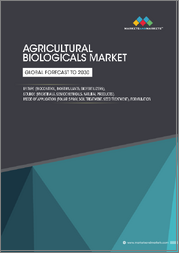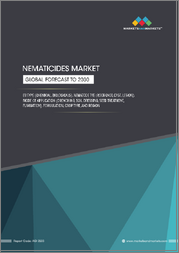
|
시장보고서
상품코드
1609912
일본의 종자 처리 시장 보고서 : 배합별, 작물 유형별, 지역별(2025-2033년)Japan Seed Treatment Market Report by Formulation (Chemical, Non-Chemical), Crop Type (Maize, Soybeans, Wheat, Rice, Canola, Cotton, and Others), and Region 2025-2033 |
||||||
일본의 종자 처리 시장의 시장 규모는 2024년에 5억 5,600만 달러에 달했습니다. 향후 IMARC Group은 시장이 2033년까지 9억 9,700만 달러에 달하며, 2025-2033년 6.7%의 성장률(CAGR)을 보일 것으로 예측하고 있습니다. 지속가능 농법의 채택이 증가하며, 농가 사이에서 화학제품의 사용량 삭감에 대한 관심이 높아지고 있는 것이 주로 시장 성장의 원동력이 되고 있습니다.
본 리포트에서 답변하는 주요 질문
- 일본의 종자 처리 시장은 지금까지 어떻게 추이하며, 향후 어떻게 추이하는가?
- 일본의 종자 처리 시장에 COVID-19가 미친 영향은?
- 일본의 종자 처리 시장의 배합별 내역은?
- 일본의 종자 처리 시장의 작물 유형별 내역은?
- 일본의 종자 처리 시장의 밸류체인에는 어떤 단계가 있는가?
- 일본의 종자 처리에서 주요 촉진요인과 과제는 무엇인가?
- 일본의 종자 처리 시장의 구조와 주요 기업은?
- 일본의 종자 처리 시장에서 경쟁의 정도는?
목차
제1장 서문
제2장 조사 범위와 조사 방법
- 조사의 목적
- 이해관계자
- 데이터 소스
- 시장 추정
- 조사 방법
제3장 개요
제4장 일본의 종자 처리 시장 : 서론
- 개요
- 시장 역학
- 업계 동향
- 경쟁 정보
제5장 일본의 종자 처리 시장 구도
- 과거 및 현재 시장 동향(2019-2024년)
- 시장 예측(2025-2033)
제6장 일본의 종자 처리 시장 : 배합별 내역
- 화학제품
- 비화학제품
제7장 일본의 종자 처리 시장 : 작물 유형별 내역
- 옥수수
- 대두
- 밀
- 쌀
- 카놀라
- 코튼
- 기타
제8장 일본의 종자 처리 시장 : 경쟁 구도
- 개요
- 시장 구조
- 시장 기업 포지셔닝
- 주요 성공 전략
- 경쟁 대시보드
- 기업 평가 상한
제9장 주요 기업의 개요
제10장 일본의 종자 처리 시장 : 업계 분석
- 촉진요인·억제요인·기회
- Porter's Five Forces 분석
- 밸류체인 분석
제11장 부록
KSA 24.12.26Japan seed treatment market size reached USD 556 Million in 2024. Looking forward, IMARC Group expects the market to reach USD 997 Million by 2033, exhibiting a growth rate (CAGR) of 6.7% during 2025-2033. The rising adoption of sustainable farming practices, along with the growing focus among farmers on reducing chemical usage, is primarily driving the market growth.
Seed treatment is an agricultural practice that involves the application of various chemical or biological substances to seeds before they are planted. The purpose of seed treatment is to protect seeds and young seedlings from a wide range of pests, diseases, and environmental stress factors. These treatments can include fungicides to prevent fungal infections, insecticides to deter insect pests, and even biological agents like beneficial microorganisms to enhance plant growth and disease resistance. Seed treatment is an effective and efficient way to safeguard crops during their early stages of growth, as it provides protection right from the start, reducing the need for post-emergence treatments and promoting healthier, more vigorous plants. This practice contributes to improved crop yields, reduced environmental impact through targeted pesticide application, and ultimately, more sustainable and productive agriculture.
Japan Seed Treatment Market Trends:
The Japan seed treatment market is a pivotal segment within the country's agriculture and agribusiness sector. Renowned for its commitment to technological innovation and sustainable farming practices, Japan has been actively adopting and advancing seed treatment solutions. Key factors contributing to the growth of this market include the need to enhance crop productivity, ensure crop health, and reduce the environmental impact of agriculture. Japanese farmers are increasingly recognizing the benefits of seed treatment, which involves the application of pesticides, fungicides, and beneficial microorganisms to seeds before planting. This practice provides early protection to emerging plants, improving resistance to pests and diseases. As Japan places a strong emphasis on sustainable agriculture and reducing chemical usage, seed treatment aligns with the country's goals of environmentally responsible farming. Collaboration between the agricultural industry, research institutions, and government initiatives further fosters innovation in seed treatment techniques. The Japan seed treatment market is thus positioned to play a pivotal role in advancing agricultural practices that are not only efficient and productive but also environmentally sustainable.
Japan Seed Treatment Market Segmentation:
Formulation Insights:
- Chemical
- Non-Chemical
Crop Type Insights:
- Maize
- Soybeans
- Wheat
- Rice
- Canola
- Cotton
- Others
Competitive Landscape:
The market research report has also provided a comprehensive analysis of the competitive landscape in the market. Competitive analysis such as market structure, key player positioning, top winning strategies, competitive dashboard, and company evaluation quadrant has been covered in the report. Also, detailed profiles of all major companies have been provided.
Key Questions Answered in This Report:
- How has the Japan seed treatment market performed so far and how will it perform in the coming years?
- What has been the impact of COVID-19 on the Japan seed treatment market?
- What is the breakup of the Japan seed treatment market on the basis of formulation?
- What is the breakup of the Japan seed treatment market on the basis of crop type?
- What are the various stages in the value chain of the Japan seed treatment market?
- What are the key driving factors and challenges in the Japan seed treatment?
- What is the structure of the Japan seed treatment market and who are the key players?
- What is the degree of competition in the Japan seed treatment market?
Table of Contents
1 Preface
2 Scope and Methodology
- 2.1 Objectives of the Study
- 2.2 Stakeholders
- 2.3 Data Sources
- 2.3.1 Primary Sources
- 2.3.2 Secondary Sources
- 2.4 Market Estimation
- 2.4.1 Bottom-Up Approach
- 2.4.2 Top-Down Approach
- 2.5 Forecasting Methodology
3 Executive Summary
4 Japan Seed Treatment Market - Introduction
- 4.1 Overview
- 4.2 Market Dynamics
- 4.3 Industry Trends
- 4.4 Competitive Intelligence
5 Japan Seed Treatment Market Landscape
- 5.1 Historical and Current Market Trends (2019-2024)
- 5.2 Market Forecast (2025-2033)
6 Japan Seed Treatment Market - Breakup by Formulation
- 6.1 Chemical
- 6.1.1 Overview
- 6.1.2 Historical and Current Market Trends (2019-2024)
- 6.1.3 Market Forecast (2025-2033)
- 6.2 Non-Chemical
- 6.2.1 Overview
- 6.2.2 Historical and Current Market Trends (2019-2024)
- 6.2.3 Market Forecast (2025-2033)
7 Japan Seed Treatment Market - Breakup by Crop Type
- 7.1 Maize
- 7.1.1 Overview
- 7.1.2 Historical and Current Market Trends (2019-2024)
- 7.1.3 Market Forecast (2025-2033)
- 7.2 Soybeans
- 7.2.1 Overview
- 7.2.2 Historical and Current Market Trends (2019-2024)
- 7.2.3 Market Forecast (2025-2033)
- 7.3 Wheat
- 7.3.1 Overview
- 7.3.2 Historical and Current Market Trends (2019-2024)
- 7.3.3 Market Forecast (2025-2033)
- 7.4 Rice
- 7.4.1 Overview
- 7.4.2 Historical and Current Market Trends (2019-2024)
- 7.4.3 Market Forecast (2025-2033)
- 7.5 Canola
- 7.5.1 Overview
- 7.5.2 Historical and Current Market Trends (2019-2024)
- 7.5.3 Market Forecast (2025-2033)
- 7.6 Cotton
- 7.6.1 Overview
- 7.6.2 Historical and Current Market Trends (2019-2024)
- 7.6.3 Market Forecast (2025-2033)
- 7.7 Others
- 7.7.1 Historical and Current Market Trends (2019-2024)
- 7.7.2 Market Forecast (2025-2033)
8 Japan Seed Treatment Market - Competitive Landscape
- 8.1 Overview
- 8.2 Market Structure
- 8.3 Market Player Positioning
- 8.4 Top Winning Strategies
- 8.5 Competitive Dashboard
- 8.6 Company Evaluation Quadrant
9 Profiles of Key Players
- 9.1 Company A
- 9.1.1 Business Overview
- 9.1.2 Product Portfolio
- 9.1.3 Business Strategies
- 9.1.4 SWOT Analysis
- 9.1.5 Major News and Events
- 9.2 Company B
- 9.2.1 Business Overview
- 9.2.2 Product Portfolio
- 9.2.3 Business Strategies
- 9.2.4 SWOT Analysis
- 9.2.5 Major News and Events
- 9.3 Company C
- 9.3.1 Business Overview
- 9.3.2 Product Portfolio
- 9.3.3 Business Strategies
- 9.3.4 SWOT Analysis
- 9.3.5 Major News and Events
- 9.4 Company D
- 9.4.1 Business Overview
- 9.4.2 Product Portfolio
- 9.4.3 Business Strategies
- 9.4.4 SWOT Analysis
- 9.4.5 Major News and Events
- 9.5 Company E
- 9.5.1 Business Overview
- 9.5.2 Product Portfolio
- 9.5.3 Business Strategies
- 9.5.4 SWOT Analysis
- 9.5.5 Major News and Events
10 Japan Seed Treatment Market - Industry Analysis
- 10.1 Drivers, Restraints, and Opportunities
- 10.1.1 Overview
- 10.1.2 Drivers
- 10.1.3 Restraints
- 10.1.4 Opportunities
- 10.2 Porters Five Forces Analysis
- 10.2.1 Overview
- 10.2.2 Bargaining Power of Buyers
- 10.2.3 Bargaining Power of Suppliers
- 10.2.4 Degree of Competition
- 10.2.5 Threat of New Entrants
- 10.2.6 Threat of Substitutes
- 10.3 Value Chain Analysis



















